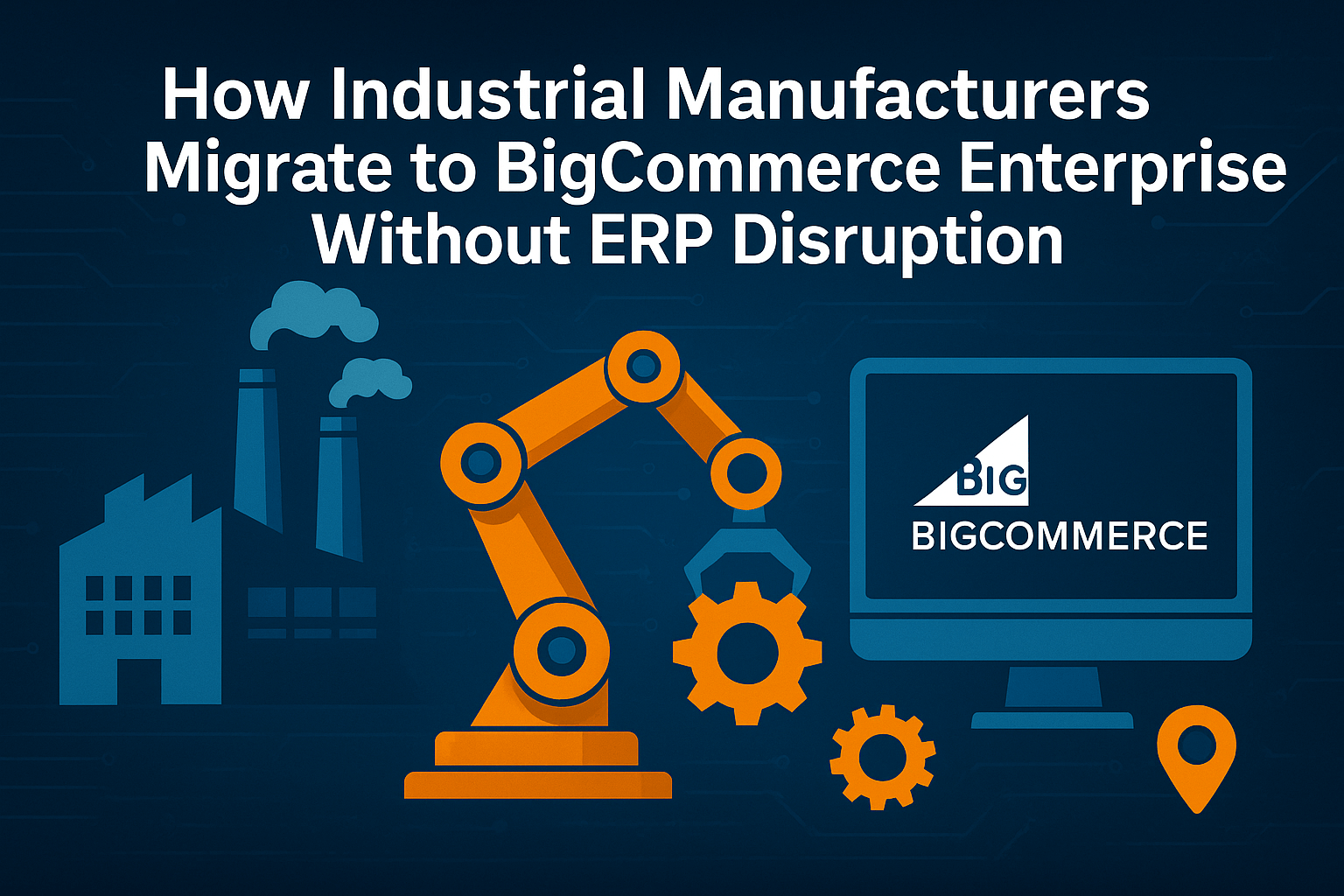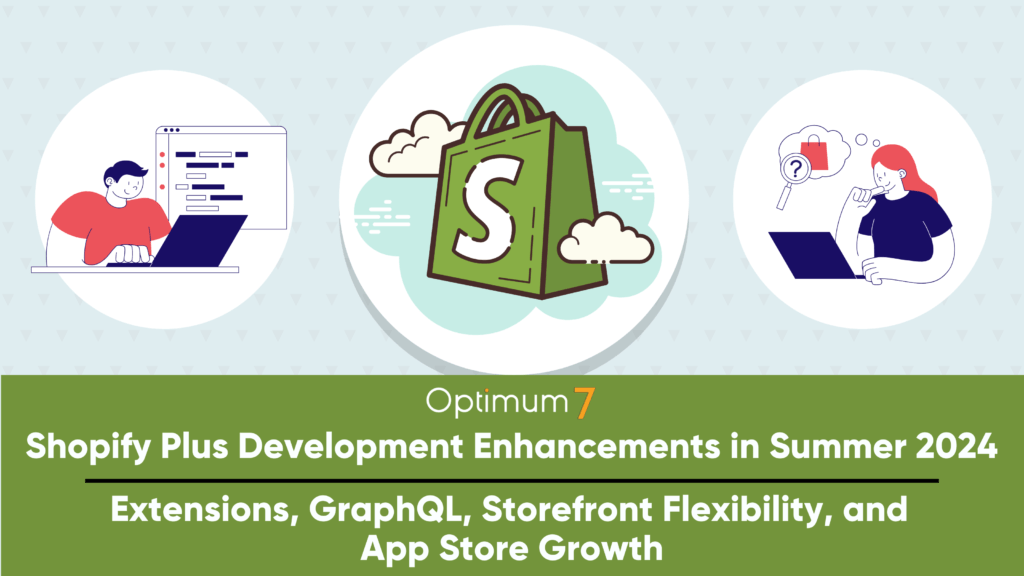Why ERP Disruption Is the Deal-Killer in eCommerce Migrations
Everyone celebrates launch day. The new BigCommerce site looks clean, the product catalog finally feels modern, and marketing is already bragging about how much easier the buyer experience is going to be. But under the surface, something small starts to go wrong. Orders come in — good news — but they don’t show up in the ERP. Inventory counts freeze. By the afternoon, the production team is asking why the system hasn’t scheduled anything new for the week.
What happens next is ugly. Customer service phones start ringing. A sales rep realizes half of the morning’s orders are still sitting in the portal with nowhere to go. Operations pulls out spreadsheets to track shipments manually, like it’s 2005 again. By the end of the week, buyers are calling their reps directly, frustrated that promised shipments haven’t left the dock.
That’s what ERP disruption looks like. Nobody cares that the new storefront has a slicker design or a better checkout flow if the backbone has snapped. In manufacturing, ERP is the backbone. And when it breaks in the middle of a migration, everything downstream breaks with it—production schedules, compliance checks, even buyer trust.
This is why industrial manufacturers can’t treat ERP as an afterthought in an eCommerce migration. A broken storefront might bruise your image. A broken ERP will cost you contracts.
The Invisible Role ERP Plays in Industrial eCommerce
ERP doesn’t get applause. It isn’t flashy, and buyers never see it. But it’s the one system that makes sure a promise made online can be fulfilled in real life.
Think about what really happens after a buyer clicks submit order. To them, the process feels instant, confirmation email, expected ship date, maybe a tracking link in a day or two. But inside the business, that single click kicks off a chain reaction. The order passes to ERP, which checks if the item is in stock. If it’s not, ERP looks at production schedules, allocates raw materials, and tells the factory floor when to build. If the order is international, ERP runs it through export compliance. If the buyer has a contract on file, ERP applies the right pricing and terms. Only then is the order truly “alive.”
And here’s the cruel irony: when ERP is working, nobody notices. Everything feels seamless. But when it misses a beat — when the integration cracks during a migration — chaos sets in. The portal still accepts orders, but nothing downstream moves. Stock levels drift out of sync. Production builds the wrong things. Buyers get promises your team can’t keep.
That’s why ERP isn’t just another system on the list when you migrate. It’s the spine holding everything upright. A better storefront is nice, but a working ERP connection is survival.
Why ERP Integrations Break During Migrations
On the whiteboard, integrations always look simple. There’s a neat little arrow from BigCommerce to SAP, another from SAP to the warehouse system, and a loop back to inventory. Drawn in marker, it’s a closed circuit, a promise that orders will flow just like they always have.
But that’s the fantasy. In the real world, ERP integrations are rarely clean. They’re usually a patchwork of custom scripts, middleware someone hacked together years ago, and connectors that were written for a platform you’ve just abandoned. Half the time, nobody still on staff remembers who built them. Documentation? If it exists, it’s out of date. And yet those fragile pipes are what keep your business running.
During a migration, those pipes get pulled apart. Maybe a field in the new BigCommerce instance doesn’t match the field SAP expects. Maybe your old platform handled order IDs one way and BigCommerce handles them another. Maybe the middleware has an update you didn’t test. The result is always the same: orders stop syncing, inventory counts freeze, and the warehouse starts calling to ask why nothing matches.
The scariest part is how fast the breakdown spreads. One connector fails, and suddenly your operations team is typing orders into ERP by hand. By the end of the day, sales reps are rekeying data, trying to keep buyers calm. By the end of the week, you’re running parallel systems: the new portal buyers see and a mess of spreadsheets your team uses to patch the holes.
That’s why ERP disruption feels like falling through the floor. Everything looks fine until the moment it isn’t, and when it fails, it takes every department with it.
The Cost of ERP Disruption for Manufacturers
When ERP breaks during a migration, the damage doesn’t unfold slowly. It hits in layers—operational, financial, and relational—all at once.
The operations team feels it first; orders pile up in the portal but never make it to ERP, and warehouse staff are left picking from stale data. The wrong SKUs get shipped, while the right ones sit untouched on the shelf. and production runs are scheduled based on faulty counts. By the end of the shift, no one trusts the system anymore, so they build their own workarounds. Excel sheets multiply. Phone calls fly back and forth just to confirm what should have been automatic.
The financial pain follows close behind, and every missed sync has a cost: overtime hours for staff scrambling to correct errors, expedited freight to fix late shipments, and penalty fees from customers whose contracts guarantee on-time delivery. And those costs don’t just dent margins—they snowball. A single week of ERP disruption can erase months of careful cost control.
But the deepest wound is relational. Buyers don’t see the technical explanation, and they don’t care about field mismatches or broken connectors. What they see is a supplier who can’t deliver. A purchase order that was supposed to ship in three days is late by two weeks. A critical part doesn’t arrive when a plant is down. Trust—the thing manufacturers spend years building—erodes in a matter of days. And once it slips, it doesn’t come back easily.
That’s why ERP disruption is so dangerous. It’s not just a system hiccup. It’s a breach of confidence. And in manufacturing, where contracts depend on reliability, that breach can cost far more than any technical fix. It can cost the relationship itself.
What a “No-Disruption” Migration Looks Like
A clean migration doesn’t feel dramatic. In fact, if it’s done right, most people inside the company barely notice it happened. Orders come in through the new BigCommerce storefront, and without a hiccup, they flow into ERP. Inventory counts stay aligned across warehouses. Production schedules adjust automatically. Finance keeps its audit trails intact. Buyers get their confirmations, shipments leave on time, and trust is never tested.
Getting to that calm state takes work. The key is treating ERP as the backbone from day one instead of a system you “hook up later.” In practice, that means building the integration in parallel with the new storefront, not after it. The data mappings — order IDs, SKU codes, pricing tiers, contract logic — all have to be validated in a sandbox environment where mistakes won’t cost you shipments.
It also means staging the rollout. The best BigCommerce migrations don’t flip the switch blindly. They run test orders and then batches of real orders in parallel, proving that ERP is catching and processing everything before cutting over fully. It’s the difference between testing a parachute on the ground and trying to fix it after you’ve already jumped.
When it’s handled this way, ERP isn’t the weak point. It’s the proof point. Operations don’t scramble, sales don’t babysit, and buyers never sense the transition. Instead of explaining why things went wrong, your team gets to celebrate how smoothly things moved forward.
That’s what “no-disruption” really means in a migration: not just a beautiful new portal, but a backbone that stays steady while the face of your business changes.
ERP-Specific Considerations Manufacturers Face
Every manufacturer knows their ERP isn’t just software — it’s a history book. It carries years of customization, patches, and one-off workflows that make it unique. That’s why no two migrations look alike. Moving to BigCommerce Enterprise doesn’t mean starting fresh; it means making sure your storefront bends to the quirks of the ERP that already runs your business.
SAP is the heavyweight. It’s powerful, but it’s also rigid. Many manufacturers have fields and validation rules built in years ago that no one dares touch. During a migration, even a small mismatch—like how order numbers are formatted—can throw SAP off. If you don’t test every detail of the data handshake, the system rejects orders, and suddenly the lifeblood of your business is bouncing back.
NetSuite tends to be more flexible, but it has its own traps. Its APIs are strong, yet bulk order imports can get messy. If you’re processing thousands of line items in a single day, you need to stress-test that pipeline before go-live. Otherwise, you’ll discover the bottleneck only when orders start stacking up.
Microsoft Dynamics is a different challenge altogether. Many manufacturers have spent years layering on customizations. That means no two Dynamics environments behave the same. During a migration, those custom scripts can become landmines. The only safe way through is a full audit of what’s been added, hacked, or bolted on over the years, because BigCommerce will need to adapt to those quirks, not bulldoze them.
Epicor often shows its age. Older versions don’t always play nicely with modern APIs, which makes middleware unavoidable. That’s not a dealbreaker, but it adds complexity. If you don’t account for it up front, you’ll end up duct-taping connectors at the last minute just to keep the sync alive.
The point isn’t that one ERP is “better” or “worse.” The point is that each comes with a hidden map of traps. If you assume your migration will be simple because “it worked on the old platform,” you’re setting yourself up for failure. The only way through is to respect the ERP as it is and build BigCommerce around it with eyes wide open.
How BigCommerce Enterprise Handles ERP Complexity
One of the reasons manufacturers get burned on migrations is that many platforms treat ERP integration like an afterthought, a plug-in you bolt on after launch. That works fine if you’re running a small catalog with simple orders. But for industrial manufacturers, where every purchase order has contract terms, custom pricing, and compliance hooks, “afterthought” isn’t good enough.
This is where BigCommerce Enterprise earns its place. It doesn’t come with a one-size-fits-all connector that promises the world and breaks under pressure. Instead, it gives you the flexibility to adapt integrations to your ERP’s reality. Its open APIs mean you can pass orders, pricing, and inventory data in the formats your ERP expects, not the other way around. Middleware systems like Celigo, Boomi, or MuleSoft can sit in between, translating without dropping information.
That flexibility matters because manufacturers don’t live in a clean, generic world. A company running SAP might need to validate orders against custom fields built fifteen years ago. A NetSuite customer might need real-time inventory syncing across multiple warehouses. A Dynamics shop might have a dozen custom approval workflows. BigCommerce doesn’t force you to tear those down. It gives you the room to rebuild e-commerce around them.
The most important part: the integration can be tested in parallel. You can set up a BigCommerce sandbox, wire it into your ERP, and run orders through until the flow is bulletproof. That means by the time you flip the switch, the data doesn’t just look good on a storefront, it moves the way your business needs it to.
For manufacturers, this isn’t about having the “most modern” storefront. It’s about trust. Trust that when a buyer clicks submit, the order doesn’t just land in BigCommerce; it moves seamlessly into ERP, kicks off production, and arrives where it should. BigCommerce doesn’t eliminate complexity, but it handles it without breaking the backbone you can’t afford to lose.
Building a Structured Migration Plan
The difference between a smooth migration and a chaotic one usually comes down to discipline. Too many manufacturers rush the storefront build and treat ERP as the last step. That’s when the cracks show. A structured migration flips the order: it treats ERP as the foundation and everything else as layers on top.
The first checkpoint is the audit. Before a single page is built in BigCommerce, someone has to map how orders currently move through ERP. Which fields get filled? Which custom scripts are triggered? Where does inventory update? This isn’t glamorous work, but without it, you’re guessing — and guessing is what breaks integrations.
The second checkpoint is mapping. This is where you line up the BigCommerce data model with ERP’s. A SKU in BigCommerce must mean the same thing in SAP or Dynamics. Contract pricing tiers have to carry over without distortion. Approval flows can’t be lost in translation. Every mismatch you catch here is one less fire to put out later.
The third checkpoint is the sandbox. BigCommerce makes it possible to test integrations in a safe environment before buyers ever see it. That means pushing test orders through, hammering the system with stress loads, and proving that ERP processes them exactly as expected. If an order bounces, if inventory misaligns, if compliance data goes missing, better to find out in the sandbox than in front of a buyer.
The fourth checkpoint is a phased rollout. Smart migrations don’t flip the switch on a Monday and hope for the best. They run both systems side by side for a short time. A small set of orders flows through BigCommerce into ERP while the old system still runs. Once everyone sees the data lining up—operations, finance, and compliance—only then does the full cutover happen.
Finally, there’s training. Sales reps, operations managers, and finance teams need to know what’s changed, where to look for orders, and how to troubleshoot if something feels off. A migration isn’t complete until the people running the business feel confident using the new flow.
This isn’t about dragging projects out. It’s about protecting the one system your business can’t afford to gamble with. A structured migration feels slower at first, but it’s the only way to make sure launch day isn’t followed by weeks of chaos.
The Role of Compliance and Audit Trails
In industrial manufacturing, compliance isn’t paperwork you tack on after the fact. It’s the guardrail that keeps contracts alive. Buyers expect every order, every shipment, and every invoice to leave a trail that can be audited. When ERP integrations break during a migration, those trails are the first things to go missing.
Imagine an export order moving across borders. The buyer’s system expects to see the compliance documentation logged inside ERP. But if the eCommerce portal doesn’t push the right data through, the order gets flagged at customs. Suddenly you’re not just late, you’re facing fines, penalties, or worse, a buyer who thinks you don’t take their regulatory requirements seriously.
The same goes for financial compliance. If your ERP isn’t catching tax logic, contract pricing rules, or credit terms during the migration, your books don’t line up. When auditors come calling, it isn’t enough to say, “the system was in transition.” They want clean, continuous records.
That’s why ERP stability during a BigCommerce migration isn’t just an IT concern, it’s a compliance requirement. Manufacturers who think of ERP as “back-office” forget that their largest buyers, especially in regulated industries, see it as a safeguard. If an order can’t be traced from the portal through ERP and back out to a bill of lading, that buyer won’t trust you with the next contract.
A no-disruption migration preserves more than operations. It preserves the integrity of your audit trail. Every click in BigCommerce has to map back to ERP in a way that can be defended in front of buyers, regulators, or auditors. If that chain breaks, so does confidence.
Measuring Success: Post-Migration KPIs
A migration isn’t successful just because the new storefront goes live. Success is measured in what happens after the first orders hit the system. The numbers tell you whether your ERP held steady or if cracks are hiding under the surface.
The first signal is order accuracy. Every line item in BigCommerce should match what ERP receives, no duplicates, no missing SKUs, no wrong pricing. If customer service isn’t fielding calls about “mismatched orders,” you know the handshake is working.
The second signal is inventory alignment. A buyer should never see stock online that isn’t actually available in the warehouse. If BigCommerce shows a product as available, ERP has to confirm it in real time. The closer those numbers stay, the less you’ll hear from frustrated buyers whose shipments were delayed because of phantom inventory.
The third signal is fulfillment speed. Did the migration slow you down or speed you up? A clean integration means orders move faster through ERP to production and shipping. If your lead times improved, it’s a sign the new system is doing more than keeping up, it’s adding value.
The fourth signal is internal behavior. Are operations managers still leaning on spreadsheets? Are sales reps still rekeying orders? If manual workarounds disappear, it means the system is trusted again. That trust inside your own walls is as important as the trust you’re trying to win back from buyers.
And finally, there’s buyer confidence itself. The real test is whether the calls stop. When buyers no longer ask, “Where’s my order?” and instead quietly keep placing them, that’s success. Because in manufacturing, silence isn’t just golden, it’s proof that the system is working.
Competitive Advantage of Getting It Right
Most manufacturers limp through migrations. They survive the cutover, but at a cost: angry buyers, overtime labor, damaged trust. The stories spread quickly. Procurement officers talk to each other. One missed shipment in the middle of a critical contract can stick to your reputation for years.
But the few who manage a clean migration — the ones who bring BigCommerce Enterprise online without ERP disruption — come out stronger. To buyers, they don’t just look modern. They look reliable. When everyone else in the industry has a horror story about system downtime or broken integrations, the supplier who kept orders flowing stands out as the safe bet.
That reputation is powerful. In industrial contracts, price matters, but reliability matters more. A buyer will stick with the vendor who never misses a beat, even if it means paying slightly more. Because in manufacturing, downtime costs more than a price difference ever will.
Getting ERP right also changes the dynamic with your own teams. Instead of operations wasting hours on manual workarounds, they focus on efficiency. Instead of sales reps apologizing for late orders, they’re free to pursue new accounts. Instead of IT firefighting broken connectors, they’re improving systems. Stability isn’t just a relief — it’s an accelerant.
In a market where competitors are still wrestling with broken integrations, being the one supplier who pulled off a seamless migration is a competitive weapon. Buyers remember who stumbled, and they remember who delivered without drama. And when it comes time to renew contracts or award new ones, trust tips the scale.
That’s the real advantage. BigCommerce Enterprise isn’t just a shinier storefront. With ERP intact, it becomes proof that your company can handle change without chaos — and in an industry built on long-term relationships, that proof is worth more than any marketing campaign.
ERP No-Disruption Migration Toolkit
Use this as a working guide when planning your BigCommerce migration. The goal: orders flow seamlessly into ERP from day one — no manual rekeying, no broken trust with buyers.
Pre-Flight Readiness Checklist
Confirm you’re actually ready before launch day.
| Checkpoint | Why It Matters | Status |
| ERP audit complete | Know every field, script, and workflow that must keep working | ☐ |
| Data mapping signed off | SKU, pricing, tax, contract terms aligned BC↔ERP | ☐ |
| Sandbox tested with real orders | Break it in test, not in production | ☐ |
| Rollback plan written | If things fail, you can revert in under 60 min | ☐ |
| Parallel run scheduled | Run old + new in tandem before cutover | ☐ |
ERP Adapter Scorecard
Respect the quirks of your ERP — they’re where migrations break.
| ERP | Known Risks | What to Test Hard |
| SAP | Rigid field validation, IDoc rejections | Order numbers, contract pricing |
| NetSuite | Bulk import throttling | High-volume order batches |
| Dynamics | Heavy custom scripts | Approval flows, plugins firing |
| Epicor | Legacy API gaps | Middleware resilience, inventory sync |
Cutover Playbook
A step-by-step sequence — don’t skip stages.
| Phase | Action | Success Signal |
| Sandbox | Push test orders BC→ERP | 100% match, no dupes |
| Volume test | Simulate peak traffic | <1% error rate, auto-recover |
| Parallel run | Send 5–10% live orders | ERP data aligns with legacy |
| Cutover | Switch DNS, all orders flow | First 100 orders clean |
| Rollback (if needed) | Revert, reconcile | Back to stable <60 min |
Monitoring & Alerts
Stay ahead of problems—catch them before your customers ever notice.
| Signal | Alert If | First Response |
| Order Sync Failures | More than 0.5% fail in 15 minutes | Pause the queue and check the logs before the issue snowballs. |
| Inventory Lag | Updates fall behind by 5+ minutes | Reduce stock shown online so customers don’t buy items that aren’t really available. |
| Pricing Mismatches | Top customer accounts are affected | Block the mismatched pricing and notify sales to manage expectations. |
| Export Compliance | Any international order fails | Hold the shipment and fix the compliance data before it leaves the building. |
Post-Go-Live KPIs
Measure stability not by design, but by results.
| KPI | Target |
| Order accuracy | 100% BC↔ERP match |
| Inventory alignment | <0.5% variance |
| ERP posting time | <60 sec average |
| Manual rekey events | Zero |
| Buyer support calls (“where’s my order?”) | ↓ 50% vs baseline |
ERP Stability Is the Core of eCommerce Growth
A migration isn’t judged by how sleek the new storefront looks or how fast the pages load. It’s judged by whether orders keep moving, inventory stays accurate, and buyers never feel the transition. That all comes down to ERP.
When ERP holds steady, the rest of the business breathes easy. Operations trust the numbers. Finance trusts the audit trail. Sales trust that every click in BigCommerce will flow into production without friction. Most importantly, buyers trust you to deliver.
When ERP fails, none of that matters. A missed sync doesn’t just create noise in the system — it creates broken promises. And in industrial manufacturing, broken promises cost contracts.
That’s why migrating to BigCommerce Enterprise isn’t just a technology project. It’s a business-critical moment where your backbone is tested. Get it wrong, and you’ll spend months repairing trust. Get it right, and you’ll prove to buyers and your own teams that you can modernize without losing stability.
If you’re planning a migration and you don’t know exactly how your ERP will respond, you’re gambling with more than IT. You’re gambling with revenue.
Contact us, and we’ll trace every integration point, map how orders, inventory, and pricing flow today, and stress-test your ERP connections before launch. The goal is simple: your first BigCommerce order should look exactly like your thousandth—seamless, accurate, and invisible to buyers.
Because in this business, a storefront may win attention, but ERP is what keeps the contracts alive.












